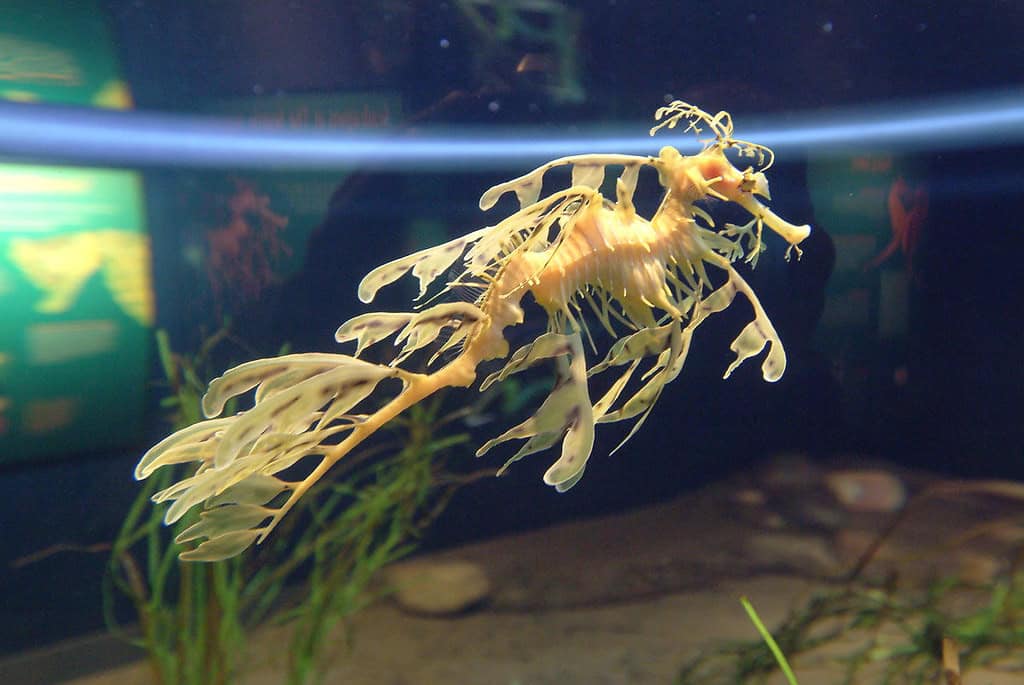In the cool waters off southern Australia, one of nature’s most extraordinary masters of disguise silently drifts with the currents. The leafy sea dragon (Phycodurus eques) represents one of evolution’s most remarkable achievements in camouflage. Unlike most marine creatures that hide or flee from predators, the leafy sea dragon has developed an appearance so perfectly mimicking its surroundings that it essentially disappears in plain sight. With elaborate leaf-like appendages extending from its body, this close relative of seahorses and pipefish has elevated camouflage to an art form.
What makes the leafy sea dragon’s disguise particularly fascinating is that it’s not a behavioral adaptation but a physical one that has evolved over millions of years. These delicate creatures grow to about 20-24 centimeters (8-10 inches) in length and move with such gentle, swaying motions that they’re almost indistinguishable from the seaweed and kelp forests they inhabit. Their exceptional camouflage ability has made them an icon of evolutionary adaptation and a symbol of the intricate relationship between marine species and their environments.
Evolutionary Marvel: The Development of Leafy Appendages

The most striking feature of the leafy sea dragon is undoubtedly its elaborate system of leaf-like appendages. These protrusions, called dermal filaments, extend from nearly every part of the animal’s body, creating a silhouette that precisely mimics the surrounding seaweed. What’s fascinating about these appendages is that they aren’t used for swimming or movement at all—they serve exclusively as camouflage. This represents a significant evolutionary investment in disguise rather than in speed, strength, or defensive capabilities.
Evolutionary biologists believe these elaborate appendages developed gradually over millions of years through natural selection. Sea dragons with more effective camouflage were less likely to be spotted by predators, increasing their chances of survival and reproduction. The result is an animal so perfectly adapted to its environment that even experienced divers can swim past them without noticing their presence. Unlike many other forms of animal camouflage that can be adjusted or modified based on surroundings, the leafy sea dragon’s disguise is permanent—a testament to the stable nature of its preferred kelp and seagrass habitats.
Masters of Color Adaptation

While the leafy appendages form the foundation of the sea dragon’s disguise, their extraordinary color adaptation capabilities elevate their camouflage to another level. Leafy sea dragons possess specialized cells called chromatophores that allow them to match the colors of their surroundings with remarkable precision. Their typical coloration includes yellows, browns, and olive greens—perfectly matching the kelp and seaweed of their native habitats. Some individuals even display hints of purple and red, corresponding to the occasional algae blooms in their environment.
What makes this color adaptation even more impressive is that it can slowly change over time. Though not as rapid as the color-changing abilities of octopuses or chameleons, leafy sea dragons can gradually shift their coloration over weeks or months to match seasonal changes in their habitat. This slow-motion color adaptation ensures they maintain optimal camouflage year-round, regardless of how the surrounding vegetation may change with the seasons or oceanic conditions. The precise color matching is so effective that even when scientists know exactly where to look, spotting a leafy sea dragon in its natural habitat remains challenging.
Movement: The Perfect Seaweed Impersonation

The disguise of the leafy sea dragon extends beyond mere appearance to include its distinctive style of movement. Unlike their seahorse cousins who swim upright, leafy sea dragons position themselves horizontally in the water, drifting with a gentle, swaying motion that precisely mimics how seaweed and kelp move with ocean currents. This movement is powered by nearly transparent pectoral fins located on their neck and a small dorsal fin on their back, which ripple with such subtlety that the propulsion appears almost magical.
This distinctive swimming style serves as a crucial component of their camouflage strategy. Moving at speeds of about 150 meters (492 feet) per hour, they’re among the slowest swimmers in the ocean. However, this seemingly disadvantageous trait actually enhances their disguise, as any rapid movement would immediately distinguish them from the surrounding vegetation. The leafy sea dragon’s entire locomotion strategy sacrifices speed for stealth—a trade-off that has proven remarkably successful in their evolutionary journey. When threatened, rather than fleeing quickly like most fish, they rely even more heavily on their camouflage, often freezing in place and swaying only with the surrounding water movement.
Habitat Selection: Choosing the Perfect Background

The leafy sea dragon’s disguise would be far less effective without its careful habitat selection. These marine creatures are exclusively found in specific locations along the southern coast of Australia, particularly around South Australia and Western Australia. Within these regions, they show a strong preference for areas where their camouflage works best: temperate coastal waters with abundant seaweed, kelp, and seagrass meadows at depths between 4 and 30 meters (13 to 98 feet). This specific habitat selection ensures their leafy appendages and coloration provide maximum concealment.
Research has shown that leafy sea dragons demonstrate remarkable site fidelity, often remaining within the same small area for extended periods. They select locations where water movement causes constant gentle swaying of vegetation, further enhancing the effectiveness of their disguise. This strategic habitat selection represents another dimension of their mastery of camouflage—they not only evolved to look like their surroundings but also carefully choose environments that maximize this advantage. Conservation efforts for the species focus heavily on preserving these specific habitat types, as the sea dragons’ specialized camouflage makes them particularly vulnerable to environmental changes.
Predator Avoidance: The Ultimate Test of Disguise
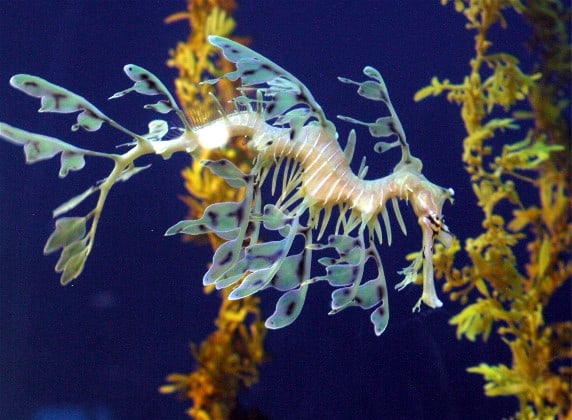
The true measure of any camouflage system is its effectiveness against predators, and by this standard, the leafy sea dragon’s disguise proves extraordinarily successful. Despite lacking the defensive spines of many marine creatures or the speed to escape predators, leafy sea dragons rarely fall victim to predation in their natural habitat. Their primary potential predators include larger fish and crustaceans that hunt by sight, precisely the type of threat their elaborate camouflage evolved to counter. When a potential predator approaches, the sea dragon’s strategy is counterintuitive but effective: rather than fleeing, it often remains perfectly still, becoming virtually indistinguishable from the surrounding vegetation.
The evolutionary success of this strategy is evident in the sea dragon’s relatively sparse defensive adaptations. Unlike many related species, they possess no venomous spines or protective armor. They have essentially placed all their evolutionary “bets” on camouflage, a specialization so successful that it has allowed them to thrive for millions of years. However, this specialization comes with risks—in environments disturbed by human activity or climate change, where their preferred hiding places may disappear, their camouflage strategy becomes less effective, making conservation of their natural habitat critically important.
The Scientific Classification of Deception

From a scientific perspective, the leafy sea dragon’s camouflage represents one of the most specialized forms of what biologists call “cryptic coloration.” This technical term describes adaptations that help an organism blend with its environment. However, the sea dragon’s approach goes beyond simple color matching to include shape, texture, and movement mimicry—a comprehensive disguise strategy that biologists classify as “masquerade camouflage.” In this sophisticated form of deception, the animal doesn’t just blend into the background but actually resembles a specific, non-threatening object in its environment.
Taxonomically, leafy sea dragons belong to the family Syngnathidae, which includes seahorses and pipefish, all known for their unusual reproductive methods and specialized body forms. However, even within this family of unique creatures, the leafy sea dragon (Phycodurus eques) stands out for its extreme adaptation toward camouflage. Its scientific classification reflects its evolutionary journey: from the Greek “phyco” (seaweed) and “odurus” (tailed), its very name acknowledges its remarkable resemblance to marine plants. This scientific recognition of its disguise capabilities underscores how central camouflage is to the species’ evolutionary strategy and ecological niche.
Unique Feeding Behaviors That Maintain the Illusion

Even when feeding, the leafy sea dragon maintains its perfect disguise. Unlike many predatory fish that actively chase their prey, leafy sea dragons are ambush feeders that rely on stealth. They have no teeth but instead possess a long, pipe-like snout that functions like a powerful vacuum. When tiny crustaceans, plankton, or small fish larvae drift by, the sea dragon creates a lightning-fast suction that draws prey into its mouth—all while barely disrupting its seaweed-like swaying motion. This specialized feeding mechanism allows it to capture prey without compromising its camouflage.
This feeding strategy is perfectly aligned with their disguise-centered lifestyle. Typical sea dragons consume hundreds of tiny prey items daily, primarily mysid shrimp (sometimes called “sea lice”) and other small crustaceans. Their hunting method is so subtle that prey animals often fail to recognize the danger until it’s too late, drifting right past what appears to be harmless seaweed before being rapidly ingested. The entire feeding process happens with such speed and minimal movement that even careful observers may miss it entirely. This ability to feed while maintaining their disguise represents yet another dimension of their comprehensive camouflage strategy.
Reproduction: Disguise During Vulnerable Moments
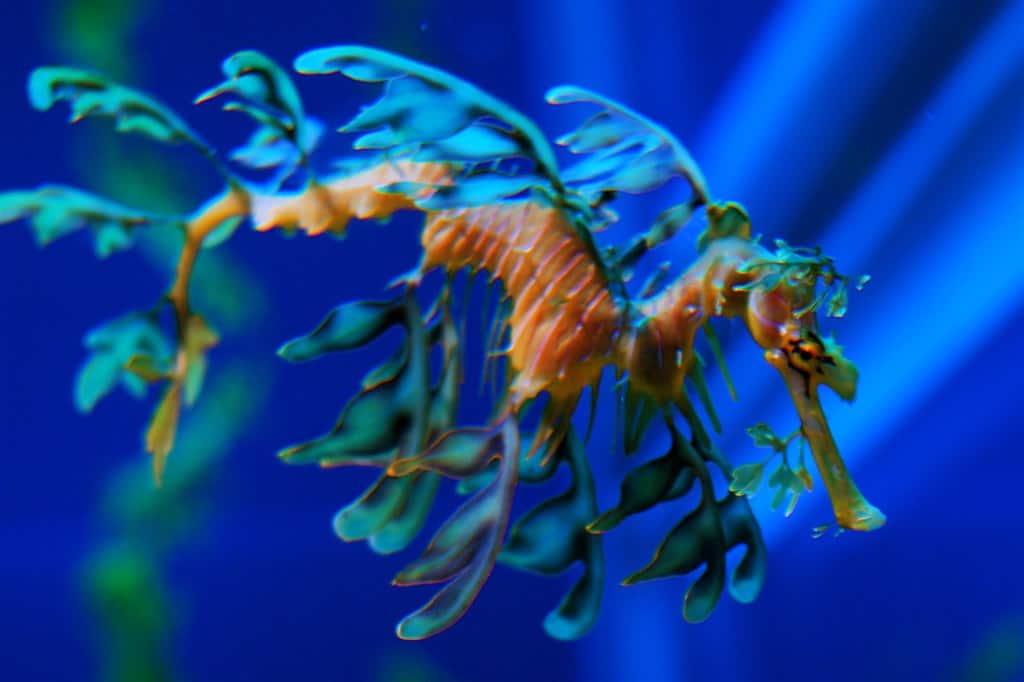
Even during reproduction, perhaps their most vulnerable life stage, leafy sea dragons maintain their camouflage advantage. Like their seahorse relatives, they exhibit male pregnancy, but with some distinctive differences. During the breeding season (late winter through early spring in the Southern Hemisphere), females produce up to 250 bright pink eggs that are transferred to the male. However, unlike seahorses that have a specialized pouch, male leafy sea dragons carry the eggs attached to the underside of their tail, where a patch of spongy tissue holds and nourishes them.
Throughout the 4-6 week gestation period, the male continues to drift among seaweed, his precious cargo partially concealed by his leafy appendages. The eggs themselves change color over time, starting bright pink but darkening to match the male’s body coloration as they develop, enhancing the camouflage. When the fully-formed baby sea dragons hatch (measuring just 20mm in length), they immediately begin life as miniature versions of their parents, complete with tiny leaf-like appendages that will grow as they mature. This immediate camouflage capability is crucial, as young sea dragons receive no parental care after hatching and must rely entirely on their disguise to avoid predation during their most vulnerable life stage.
Conservation Challenges for a Creature That Hides Too Well
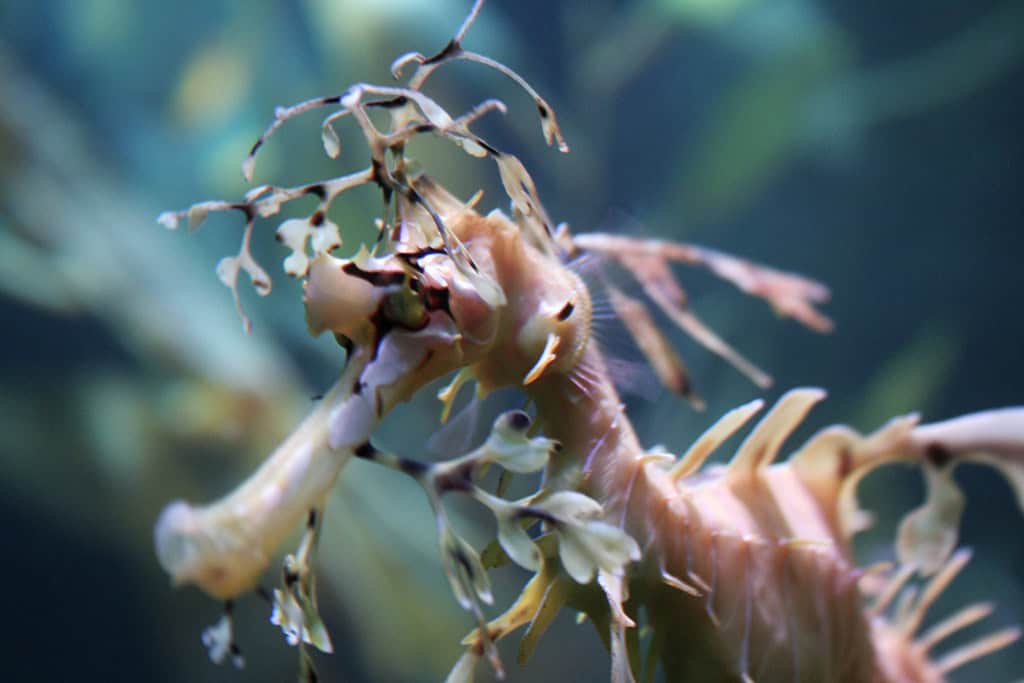
The leafy sea dragon’s extraordinary camouflage presents unique challenges for conservation efforts. Their cryptic nature makes population surveys exceptionally difficult, as traditional counting methods often miss these well-hidden creatures. Scientists estimate that wild populations have declined in recent decades, leading to their classification as “Near Threatened” on the IUCN Red List. Their limited range makes them particularly vulnerable to habitat disturbance, with coastal development, pollution, and warming ocean temperatures all threatening the specific environments their camouflage evolved to exploit.
Ironically, their captivating appearance has created another threat—collection for aquarium trade. Despite being protected by Australian law since 1987, illegal collection remains a concern, as a single specimen can fetch thousands of dollars on the international market. Captive breeding programs have had limited success, as the complex courtship rituals and specific environmental conditions required for successful reproduction are difficult to replicate in captivity. Conservation strategies now focus on marine protected areas within their range and strict trade regulations. The greatest hope for this master of disguise lies in preserving the pristine coastal environments where their remarkable camouflage can continue to serve them as it has for millions of years.
Cultural Significance and Human Fascination
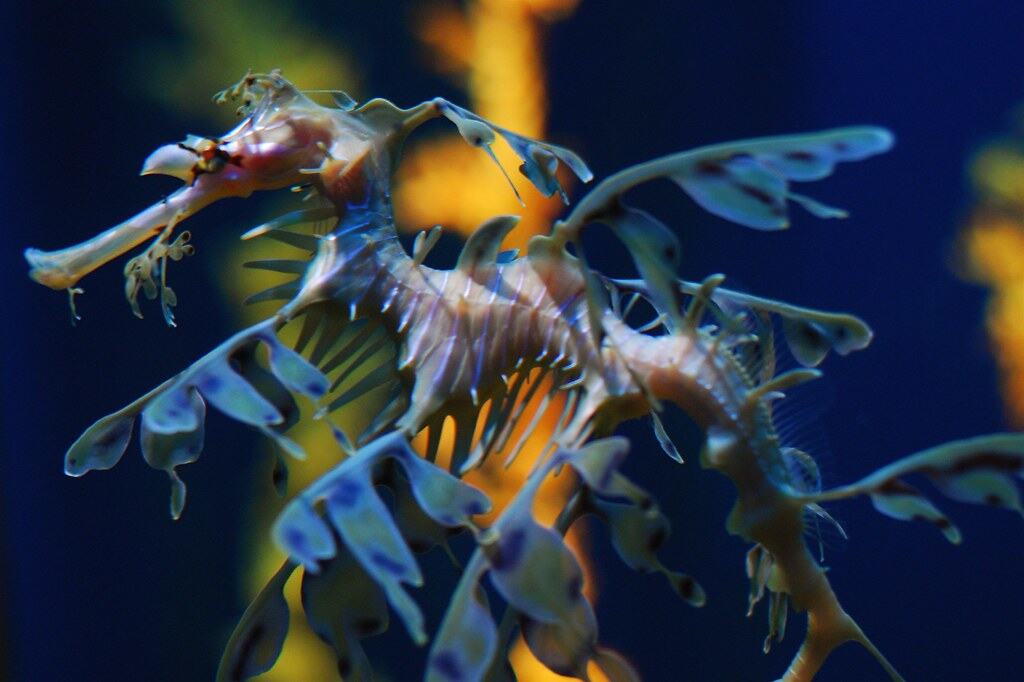
The leafy sea dragon’s extraordinary disguise has captured human imagination across cultures. For the indigenous peoples of southern Australia, particularly the Ngarrindjeri and Kaurna nations, the sea dragon holds cultural significance in stories and art, often symbolizing patience and harmony with nature. In contemporary culture, it has become an emblem of marine conservation in Australia, featured on stamps, coins, and as the official marine emblem of South Australia. Its unusual appearance has inspired artists, photographers, and designers worldwide, appearing in everything from marine-themed jewelry to architectural elements.
The scientific community shares this fascination, with marine biologists continuing to study the complex genetics and development behind the sea dragon’s elaborate appendages. Public aquariums that successfully maintain leafy sea dragons report them among their most popular attractions, with visitors often spending extended periods attempting to spot these masters of disguise even in controlled settings. This widespread human fascination with the leafy sea dragon has proven valuable for conservation, raising awareness about the fragile marine ecosystems of southern Australia and the importance of preserving these unique environments. Through this cultural significance, the sea dragon’s remarkable camouflage may ultimately contribute to its protection.
The Evolutionary Lessons of Nature’s Perfect Disguise
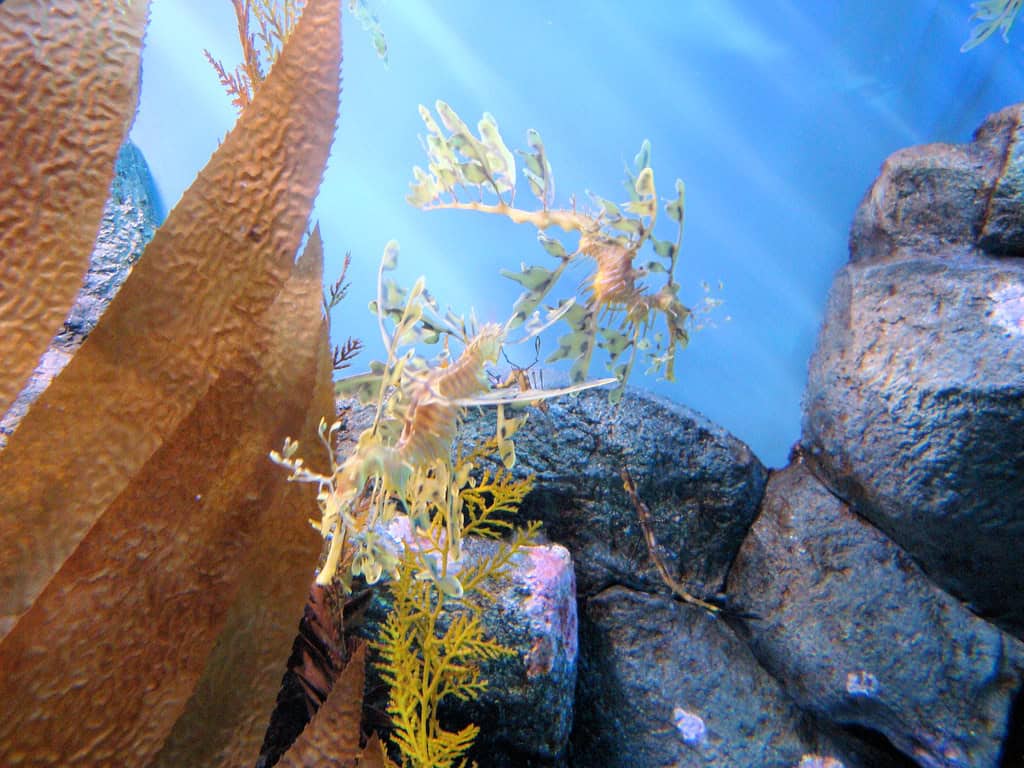
The leafy sea dragon stands as one of nature’s most compelling examples of specialized adaptation. Its extraordinary camouflage demonstrates the power of natural selection to produce seemingly impossible biological solutions when given sufficient evolutionary time. Unlike generalist species that employ multiple survival strategies, the sea dragon represents extreme specialization—investing almost entirely in disguise rather than diversifying its defensive tactics. This evolutionary path has proven remarkably successful for millions of years, allowing these delicate creatures to thrive despite lacking the teeth, speed, or venom many marine creatures rely upon for survival.
Scientists continue to learn from the leafy sea dragon’s perfect disguise, with biomimicry researchers studying its camouflage mechanisms for potential applications in fields ranging from military technology to medical devices. Its specialized adaptation reminds us that sometimes evolutionary success comes not from being the strongest or fastest, but from finding and perfecting a unique niche. The leafy sea dragon teaches us that in nature, there are many paths to survival, and sometimes the most effective strategy isn’t to confront challenges head-on, but to blend so perfectly with one’s surroundings that the challenges simply pass by, unaware of your presence. This profound lesson in adaptation continues to inspire both scientific research and conservation efforts focused on preserving this living masterpiece of evolutionary design.
- How Penguins Take Turns at Sea and Nest to Raise Chicks - August 9, 2025
- Dolphin Brains Compare to Those of Apes and Humans - August 9, 2025
- 14 Cutting-Edge Biotech Innovations That Will Shape the Future - August 9, 2025

